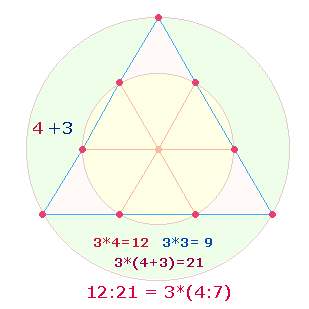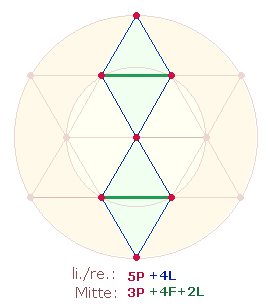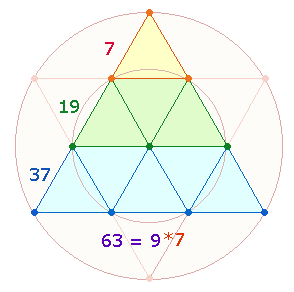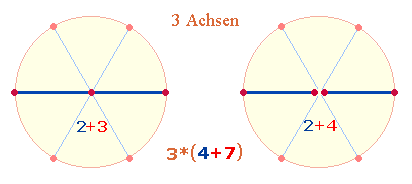Ovid's and
Shakespeare's Epitaphs
The words of
beginning, centre and end
I. 4 WORDS
a) OVID
b) SHAKESPEARE
II. 4 WORDS + 2 texts
a) OVID
III. OSSA BONES
I.
4 WORDS
1.
The obvious parallels between the two epitaphs can
only be thought possible if Shakespeare had become entirely familiar with all gematric
aspects of Ovid's epitaph. This may prove true especially of the words at the
beginning, in the centre and the end of the text.
Ovid's
epitaph consists of 26, Shakespeare's of 28 words. Therefore the centre is represented by
two words in the positions 13+14 and 14+15.
In
gematrical respect the poet had to consider the four words and the two main
text parts in between the four words. He starts with the numerical sums (NS) and successively includes the factoral sums (FS) and the factoral values (FV1, FV2) of the single sums. I confine myself to
as few aspects as necessary.
2. The 4values of Ovid's four words are:
|
|
NS |
FS |
sm |
FV1 |
FV2 |
sm |
total |
|
HIC |
20 |
15 |
35 |
9 |
8 |
17 |
52 |
|
AT |
20 |
20 |
40 |
9 |
9 |
18 |
58 |
|
TIBI |
39 |
33 |
72 |
16 |
14 |
30 |
102 |
|
CUBENT |
62 |
51 |
113 |
33 |
20 |
53 |
166 |
|
|
141 |
119 |
260 |
67 |
51 |
118 |
378 |
|
40:72 = 8*(5:9) = 8*14 = 112; 112:48 = 16*(7:3) |
|||||||
|
141 = 3*47; 378 = 14*27 = 18*21 |
|||||||
3. The function of
the two central words AT TIBI is to hold the
whole text together.This is achieved by several ratios dominated by the number 7.
They are first possible by connecting the NS+FS and the sums of FV1+FV2.
The ratio numbers 7:3 refer to 7
hexagonal and 3 corner points of the tetractys.
The ratio of 112 to the rest of the 4values is 112:266 =
14*(
4. There is a ratio
between the FS and FV2
of all four words: 119:51 = 17*(7:3) = 170,
which connects the frame words with the whole texts by the ratio 170:1326 = 34*(
5. 141 is part of
Ovid's name: PUBLIUS (95) NASO (46), but it's also essential part of the gematric
system: 3*47 is to be undestood as 3*(4:7) as referring to the three sides of the
tetractys:
|
|
The frame of the
tetractys consists of 9 points and 9 lines, together 18 elements. However, if the elements of each side
consisting of 4 points + 3 lines are counted separately, the sum of three
sides is 21. This is the
sense of 378 = 18*21 = 27*14,
which is also the sum of the numbers from 1 to 27. There is also a connection to the double rhombus
with its ideal 27, but real 21 elements of 7 points, 10 lines
and 4 triangular areas:
|
|
The
FV of 7+10+4 are 7+7+4 = 18.
1. The 4values of Ovid's four words are:
|
|
NS |
FS |
sm |
FV1 |
FV2 |
sm |
total |
|
GOOD |
39 |
29 |
68 |
16 |
29 |
45 |
113 |
|
YE |
28 |
28 |
56 |
11 |
11 |
22 |
78 |
|
BE |
7 |
7 |
14 |
7 |
7 |
14 |
28 |
|
BONES |
52 |
37 |
89 |
17 |
37 |
54 |
143 |
|
|
126 |
101 |
227 |
51 |
84 |
135 |
362 |
|
39:52 = 13*(3:4); 28:7 = 7*(4:1); 91:35
= 7*(13:5) |
|||||||
The
number 7 plays an important role in
Shakespeare's epitaph, too.
Independent
of its numerical meaning the NS 126 is the NS+FS 74+52 of WILLIAM. The bones are what is essentially left of
the dead body, and the factoral value of a number is its essential core. So BONES is identical with WILLIAM's
remains. The NS+FV1
126+51
produces the NS 177
of WILLIAM (74) SHAKESPEARE (103).
The
NS 126 connects the four words with the total
text by the ratio 126:1116
= 18*(7:62).
2. The FS 101+FV2 84 = 185 =
5*37 make up one fourth of the 4values
of Ovid's and Shakespeare's words. (see farther below)
3. The NS+FS 70 of the middle words and of
their FV 36
correspond to the NS 70 and FS 36 of IESUS.
4. Most remarkable
are the NS+FS
of the four central words:
|
|
NS |
FS |
sm |
FV1 |
FV2 |
sm |
tot. |
|
AT |
20 |
20 |
40 |
9 |
9 |
18 |
58 |
|
TIBI |
39 |
33 |
72 |
16 |
14 |
30 |
102 |
|
sm |
59 |
53 |
112 |
25 |
23 |
48 |
160 |
|
BE |
28 |
28 |
56 |
11 |
11 |
22 |
78 |
|
YE |
7 |
7 |
14 |
7 |
7 |
14 |
28 |
|
sm |
35 |
35 |
70 |
18 |
18 |
36 |
106 |
|
tot. |
94 |
88 |
182 |
43 |
41 |
84 |
266 |
|
70:112 = 14 *(5:8); 59+35 = 94 |
|||||||
70 and 112
are the NS of IESUS
CHRISTUS. Here Shakespeare obviously takes up Ovid's NS+FS 112 and completes it by his own NS+FS 70, thus expressing a religious belief: They are
both in need of redemption and confidently hope for their eternal reward
through Jesus Christ. In return Shakespeare adds the NS
35 to achieve the NS 94 for OVIDIUS.
The
FV1+FV2 of all central words form a ratio to
the NS+FS: 14*(
II. 4 WORDS + 2 texts
1. The 4values are now enlarged by the two text parts:
|
Hic |
20 |
15 |
35 |
9 |
8 |
17 |
52 |
|
text1 |
637 |
468 |
1105 |
27 |
23 |
50 |
1155 |
|
at |
20 |
20 |
40 |
9 |
9 |
18 |
58 |
|
tibi |
39 |
33 |
72 |
16 |
14 |
30 |
102 |
|
text2 |
718 |
498 |
1216 |
361 |
88 |
449 |
1665 |
|
cubent |
62 |
51 |
113 |
33 |
20 |
53 |
166 |
|
|
1496 |
1085 |
2581 |
455 |
162 |
617 |
3198 |
|
3198 = 78*41; 1665
= 45*37; 1702 = 2*23*37 |
|||||||
|
1155+1665 = 2820 = 60*47 |
|||||||
The
product numbers 3*26*41 of the total result refer
to 26 elements of the octahedron and to 41 elements of the cross of double
rhombi and the 11, 13, 17
elements of three geometrical figures in the double rhombus
and the tetractys.
2. Furthermore,
Ovid accomplishes several substructures with results divisible preferably by 37
and 47,
and of special interest, the total of 3values
excluding the NS 1496: 1085+455+162
= 1702 = 46*37.
There
are also sums divisible by 13 and 23: 468:637 = 13*(36:49), 468+498 = 966 = 42*23, 52+1155+58
= 1265 = 5*11*23.
1. The
corresponding 4values of Shakespeare's
epitaph are:
|
GOOD |
39 |
29 |
68 |
16 |
29 |
113 |
|
|
text1 |
576 |
458 |
1034 |
18 |
231 |
249 |
1283 |
|
BE |
7 |
7 |
14 |
7 |
7 |
14 |
28 |
|
YE |
28 |
28 |
56 |
11 |
11 |
22 |
78 |
|
text2 |
540 |
412 |
952 |
18 |
107 |
125 |
1077 |
|
BONES |
52 |
37 |
89 |
17 |
37 |
54 |
143 |
|
|
1242 |
971 |
2213 |
87 |
422 |
509 |
2722 |
|
576:540 = 36*(16:15)
= 36*31 |
|||||||
|
971+87+422 = 1480 = 40*37 |
|||||||
What
strikes they eye at once is the high common factor 36
of the two text parts.
2. Most astonishing
is that Shakespeare, like Ovid, determines a 3value-sum
divisible by 37. This allows the confident conclusion that
Shakespeare had studied Ovid's epitaph most carefully.
As
the joint NS of both epitaphs is divisible by 74, the ratio of the NS
towards the other 3values is 74*(37:23:20) = 74*(37:43) = 74*80 = FV 39+13 = 52.
3. It's also by
Shakespeare's incomparable genius that the 4values
of the 8 frame words are divisible by 74: 378+362 = 740. This result produces the ratio 740*(1:7)
to the rest of the text.
1. Examining the words
of both epitaphs, we can find no parallels except one very obvious one: OSSA and BONES.
In Ovid's epitaph it is the last but one, in Shakespeare's the last word at
all. Shakespeare may have been a persistent adherent to the "old
faith" but he was certainly an English patriot. If he aspired to unite the
Heathen and Christian traditions, as gematrical evidence has hitherto strongly
suggested, he will have carefully examined the properties of the only words he
has in common with Ovid: The 4values of the
two words are presented in two combinations:
|
|
NS |
FS |
sm |
FV1 |
FV2 |
sm |
tot. |
|
OSSA |
51 |
26 |
77 |
20 |
15 |
35 |
112 |
|
BONES |
52 |
37 |
89 |
17 |
37 |
54 |
143 |
|
sm |
103 |
63 |
166 |
37 |
52 |
89 |
255 |
|
35:77 = 7*( |
|||||||
|
|
NS |
FV1 |
sm |
FS |
FV2 |
sm |
tot. |
|
OSSA |
51 |
20 |
71 |
26 |
15 |
41 |
112 |
|
BONES |
52 |
17 |
69 |
37 |
37 |
74 |
143 |
|
sm |
103 |
37 |
140 |
63 |
52 |
115 |
255 |
|
115:140 = 5*( |
|||||||
If we assume
that successive numbers are constituted by their mean values, the NS 103 is formed by the bordering number 51+52. 103
however is the NS of SHAKESPEARE.
This may be a first encouragement to him to be the poet of two cultures.
The NS+FV1 of each
word, 71+69, too, are constitutive for their
sum 140.
The NS+FS 52+37 of BONES are repeated by the sums of FV1 and FV2.
2. The FS 63 is also a strong symbol for two
ways of religious thinking, it's the NS of VESTA and YIOS,
the Roman goddess of the gematrical system and Jesus Christ, the son of God.
The number is composed of 26+37, which
represents the successive addition of 7+19+37 tetractys
elements, beginning from the first level of triangles:
|
|
3. The letters that
correspond to the factors 15*17 of 4value sum 255
are PR
occupying the inner corners of the SATOR square:
|
|
The NS of the letters PER
and NET is 37,
together 74. If the E is counted only once, the
sum is 69, the same as for SATOR. SATOR PERNET
means the creator weaves (his works) permanently.
Of course, we cannot say whether Shakespeare knew about this, but he might.
4. The 4value sum 112 = 16*7
of OSSA is also the NS+FS of AT TIBI,
the central words of Ovid's epitaph. As single digits the factors 7*16 refer to the double circle of
the hexagram 7 hexagonal
points, a second centre point and 6 points
on the outer circular line. The single digits of 112
represent the area of the inner circle and the area of the inner circle and the
outer area ring:
|
|
The area ratio 1:3 of
the two areas is a symbol for the trinitarian God which was part of the VESTA doctrine. So Ovid feels certain that his
soul and body do not cease to exist after death, but are preserved by God in
eternity.
For just the
same reason Shakespeare may have chosen the NS+FV 52+17 = 69 of BONES for the NS 1242 = 18*69 of his epitaph. 52 and 69 are the NS of OPERA and SATOR.
5. It might be
useful to present the 4values of Ovid's last
sentence:
|
Nasonis |
86 |
58 |
144 |
45 |
31 |
76 |
220 |
|
molliter |
98 |
85 |
183 |
16 |
22 |
38 |
221 |
|
ossa |
51 |
26 |
77 |
20 |
15 |
35 |
112 |
|
cubent |
62 |
51 |
113 |
33 |
20 |
53 |
166 |
|
|
297 |
220 |
517 |
114 |
88 |
202 |
719 |
|
220:297
= 11*( |
|||||||
The single
digits of the ratio numbers
|
|
The graphic
shows the double aspect of 5 diametrical
elements and 2*3 radial elements that lead
to the combination of 4 radial lines and 7 points.
The 4values sum 719
is prime. The 1 adds a second central point
to the 9 diametrical elements of the hexagram
and the 7 points of the double
rhombus. Shakespeare curiously determined the prime number 971 for the FS
of his epitaph. Perhaps he did so in answer to Ovid's construction in order to
transfer Ovid's wish for undisturbed rest also to himself.
Written: May 2014





